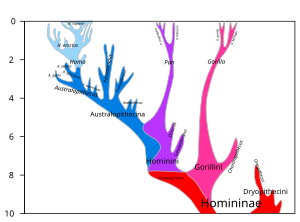শিম্পাঞ্জি - মানুষের শেষ সাধারণ পূর্বপুরুষ
শিম্পাঞ্জি - মানুষের শেষ সাধারণ পূর্বপুরুষ (chimpanzee–human last common ancestor) বা CHLCA হচ্ছে Hominini ট্রাইব এর Homo (মানুষ) এবং Pan (শিম্পাঞ্জী) - উভয় গণেরই শেষ সাধারণ পূর্বপুরুষ। জটিল সংকর প্রজাত্যায়ন এর কারণে, এই ঐতিহাসিক প্রাণীর উপস্থিতির নির্দিষ্ট সময়কাল বলা সম্ভব নয়। ১৩ মিলিয়ন বছর পূর্বে; মায়োসিন যুগে শিম্পাঞ্জি ও মানুষের জনগোষ্ঠী একে অপর থেকে বিচ্ছিন্ন হয়। কিন্তু এর সংকরায়ন ৪ মিলিয়ন বছর পূর্ব অর্থাৎ প্লায়োসিন যুগ পর্যন্ত চলতে থাকে।

দেখা যায় প্যান থেকে হোমো গণে প্রজাত্যায়ন ছিল একটি দীর্ঘ প্রক্রিয়া। প্যাটারসন (২০০৬) এর মতে, প্রাথমিক বিচ্যুতির পর, এই দুই জনগোষ্ঠীর মধ্যে সংকরায়ন ঘটে, এবং এরকম পর্যায়ক্রমিক বিচ্যুতি ও সংকরায়ন আরও কয়েক মিলিয়ন বছর পর্যন্ত চলতেই থাকে।[১] শেষ মায়োসিন ও প্রাথমিক প্লায়োসিন যুগের কোন সময়ে, মানব ক্ল্যাডের প্রথম সদস্যরা Pan গণ হতে চূড়ান্তভাবে বিচ্ছিন্ন হয়ে যায়, যা ১৩ মিলিয়ন[২] বছর পূর্বের সময়কাল থেকে ৪ মিলিয়ন বছর পূর্বের সময়কালের মধ্যে ঘটেছিল।[১] ওয়াকালি পরবর্তী সময়ে ঘটা সংকরায়নের যুক্তিকে অস্বীকার করেন।[৩]
রিচার্ড র্যাংহাম (২০০১) বলেন CHLCA (শিম্পাঞ্জি - মানুষের শেষ সাধারণ পূর্বপুরুষ) প্রজাতির সাথে কমন শিম্পাঞ্জী ( Pan troglodytes শিম্পাঞ্জী এর বর্তমান দুটি প্রজাতির মধ্যে একটি) এর সাদৃশ্য অনেক। এদের সাদৃশ্য এতটাই বেশি যে একে Pan গণ (শিম্পাঞ্জী এর গণ) এর একটি সদস্য হিসেবেই গণ্য করা যায়, এবং এদেরকে Pan prior শ্রেণীকরনী নামটি দেয়া যায়।[৪] যাই হোক, এই পর্যন্ত CHLCA বা Pan prior এর কোন সদ্যস্যের ফসিলকে শনাক্ত করা যায় নি।
মানব জিনগত গবেষণায়, CHLCA-কে মানব জনগোষ্ঠীর সিঙ্গল-নিউক্লিওটাইড পলিমরফিজম (SNP) রেট নির্ণয় করতে এংকর পয়েন্ট হিসেবে কাজে লাগানো হয়, যেখানে শিম্পাজীকে বহির্গোষ্ঠী হিসেবে, অর্থাৎ Homo sapiens এর সবথেকে বেশি জিনগত সদৃশ অদ্যাপি বর্তমান প্রজাতি হিসেবে ধরা হয়।
তথ্যসূত্র
সম্পাদনা- ↑ ক খ Patterson N, Richter DJ, Gnerre S, Lander ES, Reich D (২০০৬)। "Genetic evidence for complex speciation of humans and chimpanzees"। Nature। 441 (7097): 1103–8। ডিওআই:10.1038/nature04789। পিএমআইডি 16710306।
- ↑ Arnason U, Gullberg A, Janke A (১৯৯৮)। "Molecular timing of primate divergences as estimated by two nonprimate calibration points"। J. Mol. Evol.। 47 (6): 718–27। ডিওআই:10.1007/PL00006431। পিএমআইডি 9847414।
- ↑ Wakeley J (২০০৮)। "Complex speciation of humans and chimpanzees"। Nature। 452 (7184): E3–4। ডিওআই:10.1038/nature06805। পিএমআইডি 18337768। "Patterson et al. suggest that the apparently short divergence time between humans and chimpanzees on the X chromosome is explained by a massive interspecific hybridization event in the ancestry of these two species. However, Patterson et al. do not statistically test their own null model of simple speciation before concluding that speciation was complex, and—even if the null model could be rejected—they do not consider other explanations of a short divergence time on the X chromosome. These include natural selection on the X chromosome in the common ancestor of humans and chimpanzees, changes in the ratio of male-to-female mutation rates over time, and less extreme versions of divergence with gene flow. I therefore believe that their claim of hybridization is unwarranted."
- ↑ "Out of the Pan, Into the Fire" in: Frans B. M. De Waal, সম্পাদক (২০০১)। Tree of Origin: What Primate Behavior Can Tell Us About Human Social Evolution। পৃষ্ঠা 124–126। আইএসবিএন 9780674010048।